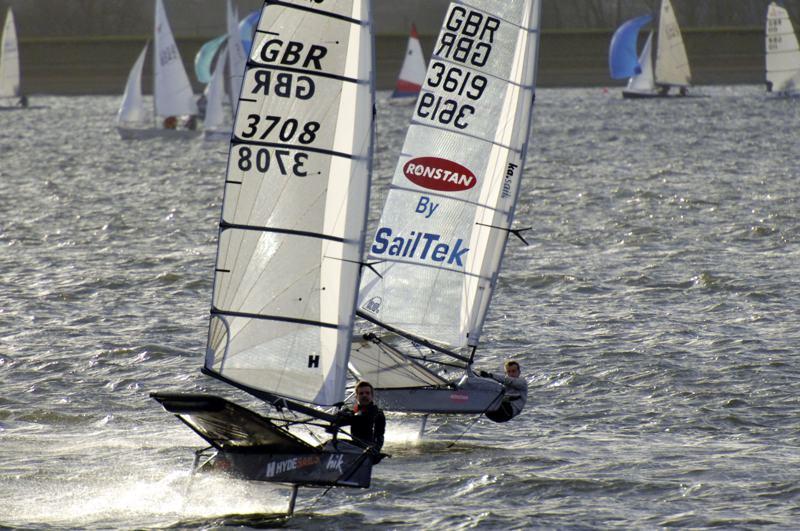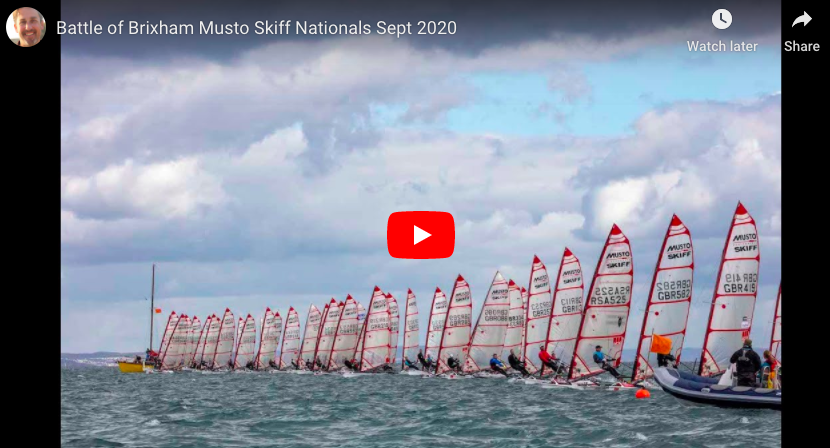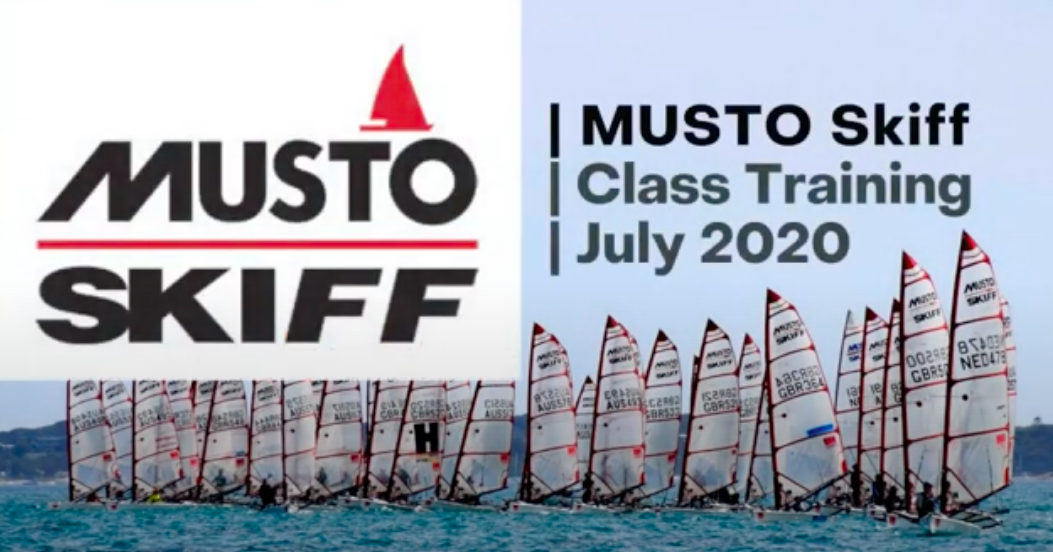Roll Tacks - April 2014
Much as I love my Musto Skiff, the number of days I’ve missed this past windy winter has made me question whether I should be a Laser sailor instead. Launching off the stony beach of Stokes Bay, which faces south-west towards directly towards the prevailing breeze, is not to be undertaken lightly in a Musto Skiff. Generally I don’t attempt launching into a windy south-westerly unless there’s someone else who can take the trolley and hold the windward rack while I get some rudder down, steady the boat, and steady my nerves.
Strangely I’ve discovered it’s much easier to get going with no daggerboard and just a bit of rudder. Provided you get the waves on the windward side of the bow, you sail off in a slightly-better-than-parallel angle away from the shore until you get into deep enough water to get the rest of the rudder down, and only then start putting in the daggerboard. It’s counter-intuitive, but is a lot more stable and easier to control than with half board and half rudder. But as to what happens if I were to capsize with no daggerboard in the slot - well I’ll cross that bridge when I come to it!
If that all sounds stressful, well it is. But once you’re out in a Musto Skiff on the Solent, there are few better experiences, especially with such a great squad of talented sailors to train with. What might well be even more fun is sailing an International Moth on foils, something I have yet to try. I’ve got some sense of what it must be like from sailing my foiling RS600FF - perhaps the singlemost exciting sailing I’ve ever done - but no doubt this pales against the zippier, more responsive performance of a Moth that’s bang up to date with all the bells and whistles.
So why sail a Laser? Because they get the biggest fleets at Stokes Bay, the competition is great, and they can get off the beach in almost any weather. And the winter of 2013/14 has been almost any weather! They have kept on racing whilst the more thrilling classes like the Musto and the Moth have mostly sat ashore, or else the sailors have got their windsurfers out and got their kicks a different way. For pure time on the water, you can’t beat a simple hiking boat. But for kicks and adrenalin rush, you can’t beat a high performance boat, one that combines trapeze AND foils.
Funnily enough the RS600FF is one of the safest, most seaworthy boats I have sailed. In full-foiling mode it is very hard to sail, although I’m told some simple modifications to the wand and the gearing mechanisms could make the world of difference. But when I’ve been caught out in a strong breeze on the Solent, you can disengage the central foil and use the rudder foil to stick the transom in the water and the bow in the air. Downwind it is much safer and easier than a conventional RS600, and tacking and gybing much less tippy because of the water resistance provided by the wings on the daggerboard.
The foiling 600 was on to a good thing, until the suicidal decision to start building them in carbon, immediately elevating the price to Moth levels and making the rest of us early pioneers feel like we were wasting our time in obsolete cast-offs. That effectively killed off the class. But Rutland sailor Matt Botfield is resurrecting the class at the moment, and it would be great to get a few of us back in the same stretch of water again. Hard to imagine that at one point there were 20 gathered for a national championships.
I do look with envy at the Moths, just can’t afford the investment of time or money. With entries to the World Championships already in excess of 120, Hayling Island is set to host the biggest Worlds ever for this thriving class. The last time the Moths had their Worlds in the UK, it was Weymouth in 2008. It was super-windy with lots of breakages, and the foreigners said if they were coming back to the UK it would have to be somewhere more Moth-friendly than Weymouth. So they chose Hayling Island... hmmmm. Seeing as my former 14 helmsman Mike Lennon is one of the chief event organisers, I wish him and the gang well, but I do worry about what Hayling Bay might serve up for the fleet that week in July. Fingers-crossed for a Force 3 and pancake-flat seas.
The Moths continue to show us what is possible when you have an open set of rules, and we one-design sailors should be grateful for the developments that trickle down to the rest of the sport. With the added impetus of the America’s Cup and the growing moves in the multihull world with the likes of the A-Class cats adopting a form of foiling, how long before we see an affordable, seaworthy one-design foiler? The RS600FF might have missed its window of opportunity (fingers crossed for the revival though!), but I still hope that someone will be clever enough to come up with the answer.
Strangely I’ve discovered it’s much easier to get going with no daggerboard and just a bit of rudder. Provided you get the waves on the windward side of the bow, you sail off in a slightly-better-than-parallel angle away from the shore until you get into deep enough water to get the rest of the rudder down, and only then start putting in the daggerboard. It’s counter-intuitive, but is a lot more stable and easier to control than with half board and half rudder. But as to what happens if I were to capsize with no daggerboard in the slot - well I’ll cross that bridge when I come to it!
If that all sounds stressful, well it is. But once you’re out in a Musto Skiff on the Solent, there are few better experiences, especially with such a great squad of talented sailors to train with. What might well be even more fun is sailing an International Moth on foils, something I have yet to try. I’ve got some sense of what it must be like from sailing my foiling RS600FF - perhaps the singlemost exciting sailing I’ve ever done - but no doubt this pales against the zippier, more responsive performance of a Moth that’s bang up to date with all the bells and whistles.
So why sail a Laser? Because they get the biggest fleets at Stokes Bay, the competition is great, and they can get off the beach in almost any weather. And the winter of 2013/14 has been almost any weather! They have kept on racing whilst the more thrilling classes like the Musto and the Moth have mostly sat ashore, or else the sailors have got their windsurfers out and got their kicks a different way. For pure time on the water, you can’t beat a simple hiking boat. But for kicks and adrenalin rush, you can’t beat a high performance boat, one that combines trapeze AND foils.
Funnily enough the RS600FF is one of the safest, most seaworthy boats I have sailed. In full-foiling mode it is very hard to sail, although I’m told some simple modifications to the wand and the gearing mechanisms could make the world of difference. But when I’ve been caught out in a strong breeze on the Solent, you can disengage the central foil and use the rudder foil to stick the transom in the water and the bow in the air. Downwind it is much safer and easier than a conventional RS600, and tacking and gybing much less tippy because of the water resistance provided by the wings on the daggerboard.
The foiling 600 was on to a good thing, until the suicidal decision to start building them in carbon, immediately elevating the price to Moth levels and making the rest of us early pioneers feel like we were wasting our time in obsolete cast-offs. That effectively killed off the class. But Rutland sailor Matt Botfield is resurrecting the class at the moment, and it would be great to get a few of us back in the same stretch of water again. Hard to imagine that at one point there were 20 gathered for a national championships.
I do look with envy at the Moths, just can’t afford the investment of time or money. With entries to the World Championships already in excess of 120, Hayling Island is set to host the biggest Worlds ever for this thriving class. The last time the Moths had their Worlds in the UK, it was Weymouth in 2008. It was super-windy with lots of breakages, and the foreigners said if they were coming back to the UK it would have to be somewhere more Moth-friendly than Weymouth. So they chose Hayling Island... hmmmm. Seeing as my former 14 helmsman Mike Lennon is one of the chief event organisers, I wish him and the gang well, but I do worry about what Hayling Bay might serve up for the fleet that week in July. Fingers-crossed for a Force 3 and pancake-flat seas.
The Moths continue to show us what is possible when you have an open set of rules, and we one-design sailors should be grateful for the developments that trickle down to the rest of the sport. With the added impetus of the America’s Cup and the growing moves in the multihull world with the likes of the A-Class cats adopting a form of foiling, how long before we see an affordable, seaworthy one-design foiler? The RS600FF might have missed its window of opportunity (fingers crossed for the revival though!), but I still hope that someone will be clever enough to come up with the answer.
Related Articles

Roll Tacks - December 2013
Before you got into sailing - if you can remember back that far - what did you think was meant by the term ‘dinghy’? I didn’t take up sailing until I was 13, and so to me a dinghy was a blow-up piece of plastic that you bought from a shop at the seaside and inflated on the beach while wearing your Speedos. Speedos weren’t a joke term back in the day, by the way.
Read More

256 boats ready for High Wind drama at Bloody Mary
Read More
 What has been a windy start to the GJW Direct SailJuice Winter Series looks set to continue at this weekend’s Virtual Rigger 40th Bloody Mary in London. The forecast for the pursuit race classic is a moderate to strong easterly breeze, but that hasn’t stopped 256 boats entering in advance, with the prospect of many more entering on the day.
What has been a windy start to the GJW Direct SailJuice Winter Series looks set to continue at this weekend’s Virtual Rigger 40th Bloody Mary in London. The forecast for the pursuit race classic is a moderate to strong easterly breeze, but that hasn’t stopped 256 boats entering in advance, with the prospect of many more entering on the day.

Great Ball of Fire at the Brass Monkey
Read More
With the 2012 Brass Monkey at Yorkshire Dales SC being part of the GJW Direct Sailjuice Winter Series, a bumper entry was expected, and sure enough entries had to be closed as capacity was reached weeks before the event date.

Musto Skiff Nationals Review: The Battle of Brixham
Read More

The Battle of Brixham: Sailjuice grills four of the top performers from the Musto Skiff Nationals about a whacky week in Torbay. How did they manage to keep their heads while all around others of the 53-skiff entry were losing theirs?

Noble Marine Musto Skiff Coaching Session with Russ Clark
Read More

In keeping with the ‘keep no secrets’ ethos that has made the Musto Skiff class so successful over the past 20 years, round-the-cans supremo Ben Schooling, reigning UK National Champion Jamie Hilton and reigning World Champion Bruce Keen hold nothing back as they share their best tips.
